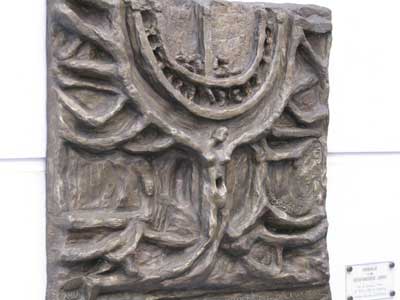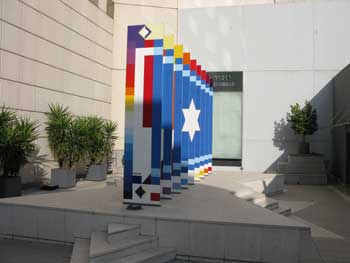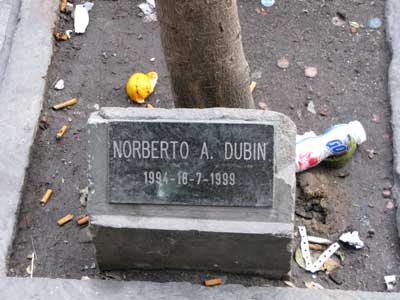Buenos Aires, Argentina
Buenos Aires is the capital and most important province in the Argentinian republic in terms of economic wealth (cattle raising, wheat farming, and industry) and concentration of population (approximately 15 million out of a total population of 45 million in 2018). The Jewish population of the capital and its suburbs (“Greater Buenos Aires”) was estimated at 159,000 in 2017.
The Province
The first colony of the Jewish Colonization Association (ICA) – Maurício (1891) – was established in Buenos Aires and was followed by the Baron Hirsch colony (1904–05) a few years later. In the early 21st century there were many small Jewish communities in the province, the largest being La Plata, Bahia Blanca, Mar del Plata, and Rivera, all affiliated with the Va’ad ha-Kehillot.
The City
During the colonial period a few Crypto Jews settled in Buenos Aires, mainly during the 16th and 17th centuries. There is evidence that the number of “Portuguese” (as many judaizers were identified at the time) of Jewish descent rose during the 18th century as Buenos Aires developed into an important administrative and commercial port city. However, there is no trace of Jews living openly as such during the time of the revolt against Spanish rule (1810), or at the time of Argentina’s declaration of independence (1816).
 Memorial dedicated to the missing Jews who disappeared during Argentina’s dictatorial government. |
During the middle decades of the 19th century Jews arrived in small number from two areas, Western Europe and Morocco. The earliest public Jewish event was an officially recognized religious marriage ceremony in 1860. The first minyan took place during Yom Kippur of 1862, which led to the founding of the first Jewish organization, the Congregación Israelita de la República Argentina (CIRA). New arrivals from North Africa and Gibraltar led to the founding of the Congregación Israelita Latina (1891).
The year 1889 saw the arrival in the port of Buenos Aires of a group of 824 Jews from Russia, most later proceeding to the Province of Santa Fe. From then on a steady migration movement from Eastern Europe ensued, helped by the open door policy in Argentina early on, and by the publicity given to Argentina in the European Jewish press as the agricultural settlements of the ICA were established and developed. Thus Argentina, especially its capital city of Buenos Aires, turned into a major target of immigration for East European Jews.
In 1909, there were approximately 25,000–30,000 Jews in Buenos Aires. In spite of some manifestations of anti-Semitism, especially during the repression against workers’ strikes during the early years of the 20th century, and the “red-scare” pogrom – known in Argentina as La Semana Trágica – of January 1919, whose main targets were Russian Jews, immigration continued unabated, interrupted only during World War I.
After the war, Jewish immigration was further enhanced by the quotas established in the United States starting in the early 1920s. By 1936, there were over 120,000 Jews in the capital, constituting over 5% of the total population. After 1933. a relatively large number of Jews from Central Europe established themselves in Buenos Aires. A few more did so after World War II from neighboring countries in South America. However, the Argentinian government closed Jewish immigration after the war, and only a small number of Jews entered after that. The city’s Jewish population increased naturally and by internal migrations from provincial cities and from the ICA settlements.
Buenos Aires was a city of immigrants, cosmopolitan in character, and the Jewish population remained diversified as well. About 85% of the Jews were Ashkenazim, the vast majority from Eastern Europe and a minority from Central Europe. The other 15% were Sephardim from various areas in the Balkans, the Middle East, and North Africa. These Jews founded their new societies and communities along the lines of their places of origin. Ashkenazim were organized in AMIA, the largest community organization in Argentina, while Sephardim organized themselves in four separate communities: Moroccan, Ladino-speaking (from Turkey and the Balkans), and two Arabic-speaking ones, the Jews from Damascus and the Jews from Aleppo.
 Statue by Israeli artist Yaacov Agam stands in the courtyard of the AMIA building as a memorial |
Each group had its own cemeteries, religious leadership, schools, and mutual-aid institutions. Most synagogues founded during the formative period by East Europeans and Sephardim were Orthodox, while those founded by the German Jews were either Conservative or Reform. During the 1950s CIRA became Conservative.
The founding of the Bet El community in 1963 and the Seminario Rabinico Latinoamericano in 1962 led to the spread of this movement not only in the city of Buenos Aires but also throughout Latin America.
The Reform movement established the Emanuel congregation in 1964. In addition, the Chabad movement has gained adherents, especially during the past generation. Nevertheless, Jewish identification is based more on national consciousness, and the influence of Israel and of Israeli political parties is greater.
This is made particularly evident by the important role of the OSA (Organización Sionista Argentina). Another central organization is DAIA, the representative body of Argentinian Jewry vis-à-vis the government and in the sphere of world Jewry.
Jewish education in the city was imparted along ideological and political lines as well as according to communal groupings. Most of the latter fall under the umbrella of the Va’ad ha-?innukh. Some of the day schools are among the best schools in the city and, at the end of the 1990s, about 50% of Jewish children of primary school age and more than a third of secondary school age were reached by them. Many cultural, social, and sports organizations served local Jewry, especially Sociedad Hebraica Argentina, Hacoaj, and Maccabi ha-Ko’a? and Hebraica.
 A plaque dedicated to a victim of the bombing at the AMIA building. |
In earlier decades Buenos Aires was a major center of Yiddish journalism, to the point that in the 1940s three Yiddish dailies were published. In addition many monthly publications in Yiddish reflected the vigorous political and ideological splits in the community, ranging from Zionism of various schools to Bundism, socialism, communism, and anarchism. Buenos Aires was also a world center for the publication of books in Yiddish and a leading city for Yiddish theater. Subsequently, Spanish became the predominant and almost exclusive language for communal publications.
The Jewish population of Greater Buenos Aires peaked somewhere in the 1950s at approximately 250,000–260,000. From then on its numbers diminished, mainly because of emigration. The largest group immigrated to Israel, mostly for ideological reasons, during the military repression of 1976–83. Israel became a haven for Jews suspected of leftist or guerilla activism. Moreover, during the Argentine economic debacle that began in 2001, another wave of immigration to Israel developed. In addition, Jews left Buenos Aires for other places in Latin America, the U.S., and Europe, mainly for professional and economic reasons, though, again during the repression, for political reasons as well. Thus, Buenos Aires, and Argentina as a whole, went from being a city of settlement to a city of exodus.
Jewish institutions were targeted during the 1990 by groups generally considered to be serving the cause of anti-Israel terrorism. The Israeli embassy in Buenos Aires was bombed in 1992 with 29 people killed, and the premises of AMIA were destroyed in a major terrorist act in 1994 which killed 85 people. The attacks are still being investigated.
Jews have played an important role in industry, commerce, the arts, literature, journalism, and politics. During the administrations of Alfonsin (1984–90) and Menem (1990–2000), Jews were visible in all spheres of government.
A disused synagogue in the La Boca neighborhood that served the first generation of Jewish immigrants to Argentina is set to be restored by the Jewish community of Buenos Aires following a legal battle with squatters won in August 2019.
BIBLIOGRAPHY
M. Bejarano, "Los sefaradies en la Argentina," in: Rumbos, 17–18 (1986),143–60; V. Mirelman, Jewish Buenos Aires 1890–1930. In Search of an Identity (1990); idem, "Jewish Life in Buenos Aires before the East European Immigration (1860–1890)," in: AJHQ, 67:3 (1978), 195–207; E. Sofer, From Pale to Pampa: A Social History of the Jews of Buenos Aires (1982); E. Zadoff, Historia de la educacion judia en Buenos Aires (1935–1957), (1994).
Sources: Encyclopaedia Judaica. © 2008 The Gale Group. All Rights Reserved;
“Historic Buenos Aires Synagogue Restored to Argentine Jewish Community,” Algemeiner, (August 8, 2019).


